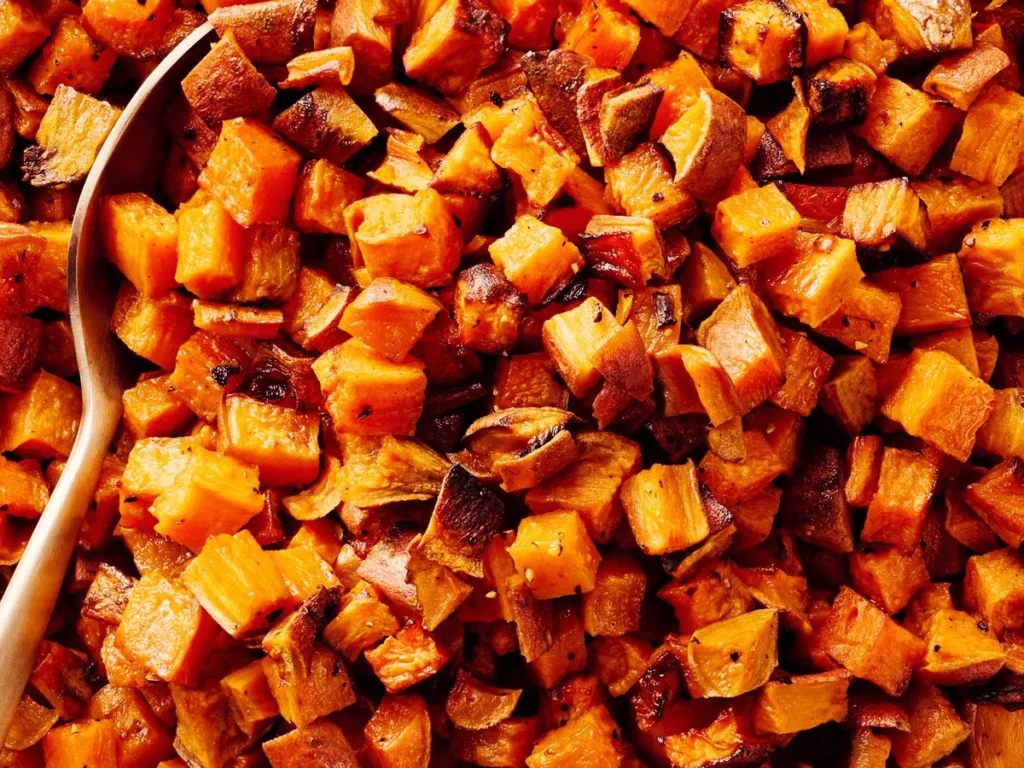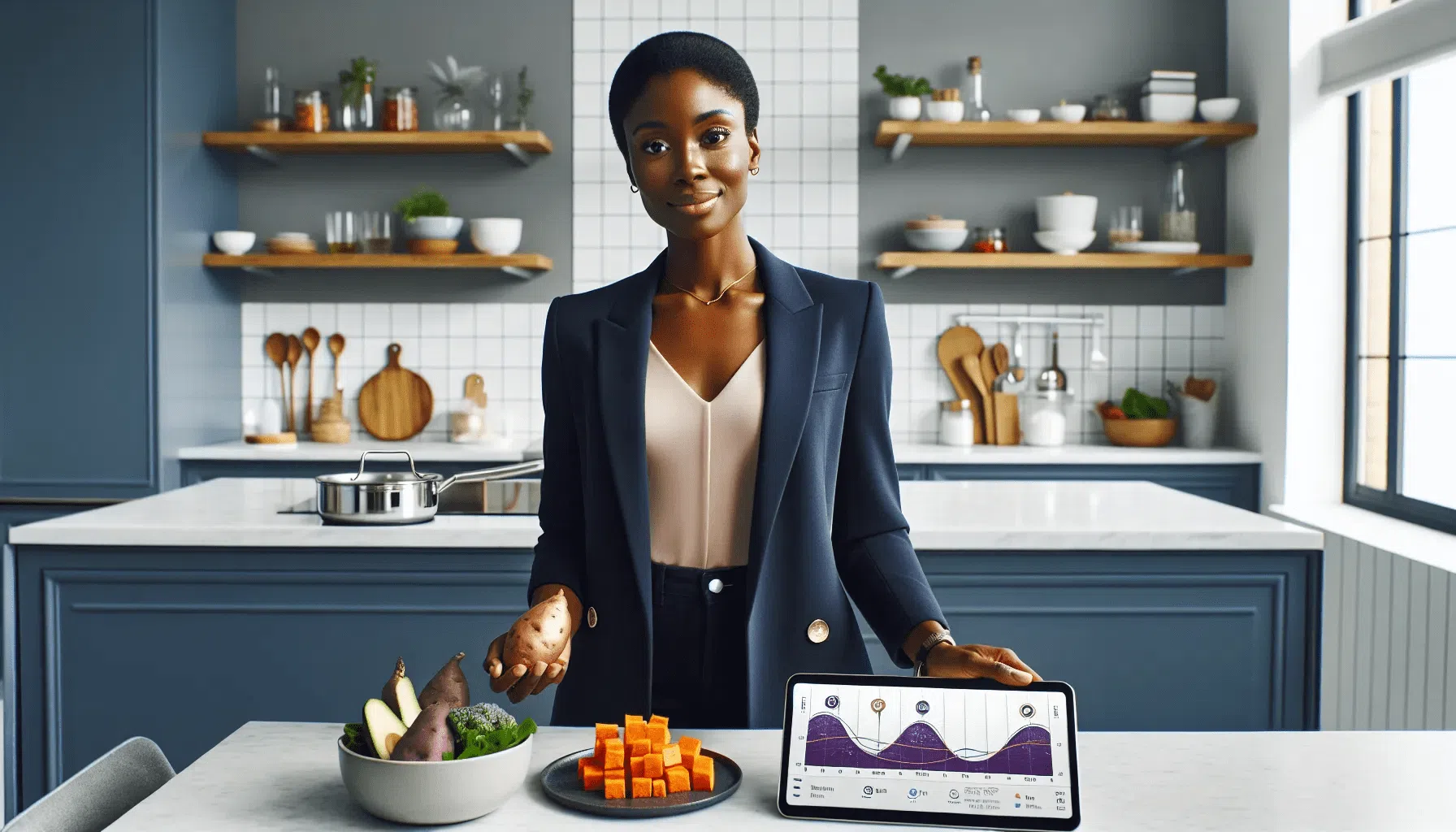You’re staring at a crate of orange gems at the store and wondering: are sweet potatoes healthy or just cleverly branded comfort food? Short answer: they’re genuinely nutrient-dense, but how you cook them and how much you eat matters. In this guide, you’ll get the sweet potato nutrition facts, what research actually says about benefits, how they compare to regular potatoes, the best cooking methods to keep blood sugar steady, and simple ways to put them on your plate without turning dinner into dessert.
Nutrition At A Glance
Calories, Carbs, And Fiber
A medium sweet potato (about 5 inches long: roughly 130–150 g) gives you a tidy nutrition package:
- About 110–120 calories
- ~26 g carbs
- 3–4 g fiber
- ~2 g protein
- Virtually no fat
That fiber (especially if you eat the skin) slows digestion, helps you feel full, and supports steady energy. For most people, one medium or 1/2–1 cup cooked is a smart serving, depending on your goals and how active you are.

Vitamins, Minerals, And Antioxidants
Sweet potatoes punch above their weight in micronutrients:
- Vitamin A: Over 100% of your daily needs as beta‑carotene (that’s the orange pigment). Your body converts it as needed, no risk of vitamin A toxicity from beta‑carotene.
- Vitamin C: Around 20–30% of your daily value (supports collagen, immune function).
- Potassium: Roughly 12–15% DV (helps regulate fluid balance and blood pressure).
- Manganese and Vitamin B6: Notable amounts for metabolism and energy.
Antioxidant profile varies by color: orange varieties are rich in beta‑carotene: purple sweet potatoes bring anthocyanins, which are linked to reduced oxidative stress. You’ll also get polyphenols like chlorogenic acids. Translation: it’s not just carbs, there’s protective chemistry in every bite.
What The Research Says About Health Benefits
Blood Sugar And Glycemic Impact
If you’ve heard sweet potatoes are “low GI,” the reality is more nuanced. Their glycemic index (GI) ranges widely with variety and cooking method. Boiling tends to produce a lower GI than baking or roasting: cooling cooked potatoes (then eating cold or reheating) increases resistant starch, which can blunt the blood sugar rise. Practically, that means:
- Boiled, cooled-and-reheated sweet potatoes often have a gentler impact than a big, hot baked one.
- Pairing them with protein, healthy fat, and leafy veggies further slows absorption.
Research on sweet potato extracts (like white sweet potato “Caiapo”) has shown improvements in insulin sensitivity in people with type 2 diabetes, but that’s not the same as eating a loaded sweet potato casserole. For everyday meals, portion size and prep method are your biggest levers.
Heart, Gut, And Immune Support
- Heart: Potassium helps counter sodium’s effect on blood pressure, and fiber supports healthier cholesterol levels over time. Pigments like anthocyanins (purple varieties) and carotenoids (orange) have been linked to better endothelial function and lower oxidative stress in observational and small clinical studies.
- Gut: The combo of soluble fiber and resistant starch (especially after cooling) feeds beneficial gut bacteria, leading to more short‑chain fatty acids, good news for gut lining health.
- Immune: Vitamin A supports the integrity of your skin and mucosal barriers (your first line of defense), while vitamin C plays a role in immune cell function and collagen repair. It’s a one‑two punch you’ll actually enjoy eating.
Sweet Potatoes Vs. Regular Potatoes
Key Differences And When To Choose Each
Both sweet and white potatoes are whole, nutrient-dense foods. They’re more alike than the internet sometimes suggests, but there are meaningful differences:
- Vitamins & antioxidants: Sweet potatoes win on vitamin A (beta‑carotene) and, if purple, anthocyanins. White potatoes provide more vitamin C in some cases.
- Potassium: White potatoes often edge higher. Both are strong sources.
- Fiber: Sweet potatoes typically have slightly more, especially with the skin.
- Glycemic response: Highly variable. Boiling and cooling lower the impact for both types. A giant baked potato of either kind can spike blood sugar in some people.
When to choose each?
- Go sweet potato when you want more beta‑carotene, subtle sweetness, or you’re making chilis, tacos, bowls, or curries that play nicely with it.
- Go white potato for ultra-neutral flavor, super budget-friendly versatility (think mash, soups), or when you need maximum potassium.
Honestly, you don’t have to pick a team, rotate them based on taste and your nutrition needs.
Cooking Methods And Portions That Maximize Benefits
Best Ways To Cook And Pair
To get the most from sweet potatoes (and keep the answer to “are sweet potatoes healthy?” a resounding yes), focus on method and mix-ins:
Best cooking methods
- Boil or steam when you want the gentlest blood sugar impact.
- Roast or air‑fry cubed pieces at moderate heat with a little olive oil to keep edges crisp without burning nutrients.
- Microwave for a fast, nutrient‑friendly option, don’t overdo cook time.
- Cook, cool, and reheat to boost resistant starch.
Smart pairings
- Add protein: eggs, salmon, chicken, tofu, Greek yogurt.
- Add healthy fats: olive oil, avocado, tahini, nut/seed sprinkle.
- Add fiber and color: leafy greens, cruciferous veggies, beans, herbs, citrus.
Portion pointers
- Everyday serving: 1/2–1 cup cooked or one small to medium potato (roughly 120–150 g).
- Use the plate method: keep starchy veggies (like sweet potatoes) to about a quarter of your plate, then fill the rest with protein and non‑starchy veggies.
What to skip (most of the time)
- Marshmallows, heavy brown sugar glazes, and syrupy casseroles turn a nutrient-dense food into dessert. Delicious? Sure. Everyday fuel? Not really.
Who Should Be Cautious
Oxalates, Potassium, And Large Portions
- Oxalates: Sweet potatoes contain oxalates, which can be an issue if you’re prone to calcium‑oxalate kidney stones. Pairing them with calcium‑rich foods (like yogurt or cheese) at the same meal can help bind oxalate in the gut.
- Potassium: If you have chronic kidney disease or take potassium‑sparing meds (ACE inhibitors, ARBs, spironolactone), talk to your clinician about appropriate portions.
- Blood sugar: Big servings (or sugary toppings) can spike glucose, especially if you have diabetes or insulin resistance. Stick to measured portions and pair with protein/fat.
- Low‑FODMAP note: Sweet potatoes are higher in mannitol at larger portions. Around 1/2 cup cooked tends to be better tolerated if you’re navigating IBS.
- Cosmetic quirk: Eat a lot of carotene‑rich foods and your palms might get a little orange (carotenemia). Harmless, and it fades.
Easy, Healthy Ways To Add Them To Your Meals
- Sheet‑pan supper: Toss sweet potato cubes with olive oil, cumin, and smoked paprika: roast with chickpeas and broccoli. Finish with lemon‑tahini.
- Breakfast hash: Sauté diced sweet potato with onions and peppers: top with eggs and a handful of arugula.
- Stuffed boats: Bake whole, split, and fill with black beans, salsa, avocado, and cilantro. A dollop of Greek yogurt beats sour cream for extra protein.
- Curry or chili: Add cubes to coconut curry or turkey chili for natural sweetness and extra fiber.
- Mash makeover: Mash with a splash of olive oil, garlic, and miso or Greek yogurt instead of butter and sugar.
- Grain bowl: Layer greens, quinoa, roasted sweet potato, shredded chicken, pumpkin seeds, and a citrus vinaigrette.
- Cold salad prep: Roast, cool, and fold into a black bean–corn salad for a resistant‑starch bump.
Conclusion
So, are sweet potatoes healthy? Yes, especially when you keep portions reasonable and lean on simple prep. You’re getting fiber, potassium, and a serious dose of vitamin A plus protective plant compounds. For steadier blood sugar, choose boiling or cook‑cool‑reheat, and pair with protein, fat, and greens. Rotate them with regular potatoes, use the plate method, and skip the sugar‑bomb toppings most nights. Do that, and sweet potatoes earn a permanent spot in your easy, everyday, feel‑good meals.
Frequently Asked Questions
Are sweet potatoes healthy?
Yes—sweet potatoes are healthy when portioned and prepared well. One medium potato (about 110–120 calories) provides roughly 26 g carbs, 3–4 g fiber, potassium, vitamin C, and over 100% daily vitamin A as beta‑carotene. Boil, steam, or cook–cool–reheat, and pair with protein, healthy fats, and greens for steadier energy.
What is the healthiest way to cook sweet potatoes for steady blood sugar?
Boiling generally yields a lower glycemic impact than baking or roasting. Cooking, cooling, then reheating boosts resistant starch. If you’re asking are sweet potatoes healthy for blood sugar, keep portions to 1/2–1 cup cooked and pair with protein, healthy fats, and leafy vegetables. Skip sugary toppings that spike glucose.
How do sweet potatoes compare to regular potatoes nutritionally?
Both are nutrient-dense, whole-food carbs. Sweet potatoes deliver significantly more vitamin A (beta‑carotene) and, in purple varieties, anthocyanins. White potatoes often edge higher in potassium and sometimes vitamin C. Fiber is similar, with a slight sweet potato lead. Glycemic response varies by type and method; boiling and cooling helps both.
What’s a sensible serving size, and who should be cautious with sweet potatoes?
A practical serving is 1/2–1 cup cooked or one small to medium potato. Be cautious if you’re prone to kidney stones (oxalates), have chronic kidney disease or take potassium‑sparing meds, or manage diabetes—larger portions and sugary add‑ons can spike glucose. For IBS, about 1/2 cup is typically better tolerated.
Are sweet potatoes healthy on a low-carb or keto diet?
On strict keto, not really. A medium sweet potato has about 26 g carbs and 3–4 g fiber, which can disrupt ketosis. For moderate low‑carb, a small 1/2‑cup portion can fit occasionally if paired with protein, non‑starchy vegetables, and fats. Nutrient‑dense, but not keto‑friendly.
Are sweet potatoes nightshades, and are they okay if I avoid nightshades?
Sweet potatoes aren’t nightshades; they’re part of the morning glory family (Convolvulaceae), not Solanaceae. If you avoid nightshades for personal tolerance, sweet potatoes are generally fine. Still consider portion size, carbs, and oxalates if you’re prone to kidney stones. Cooking and pairing with calcium‑rich foods can help mitigate oxalates.

